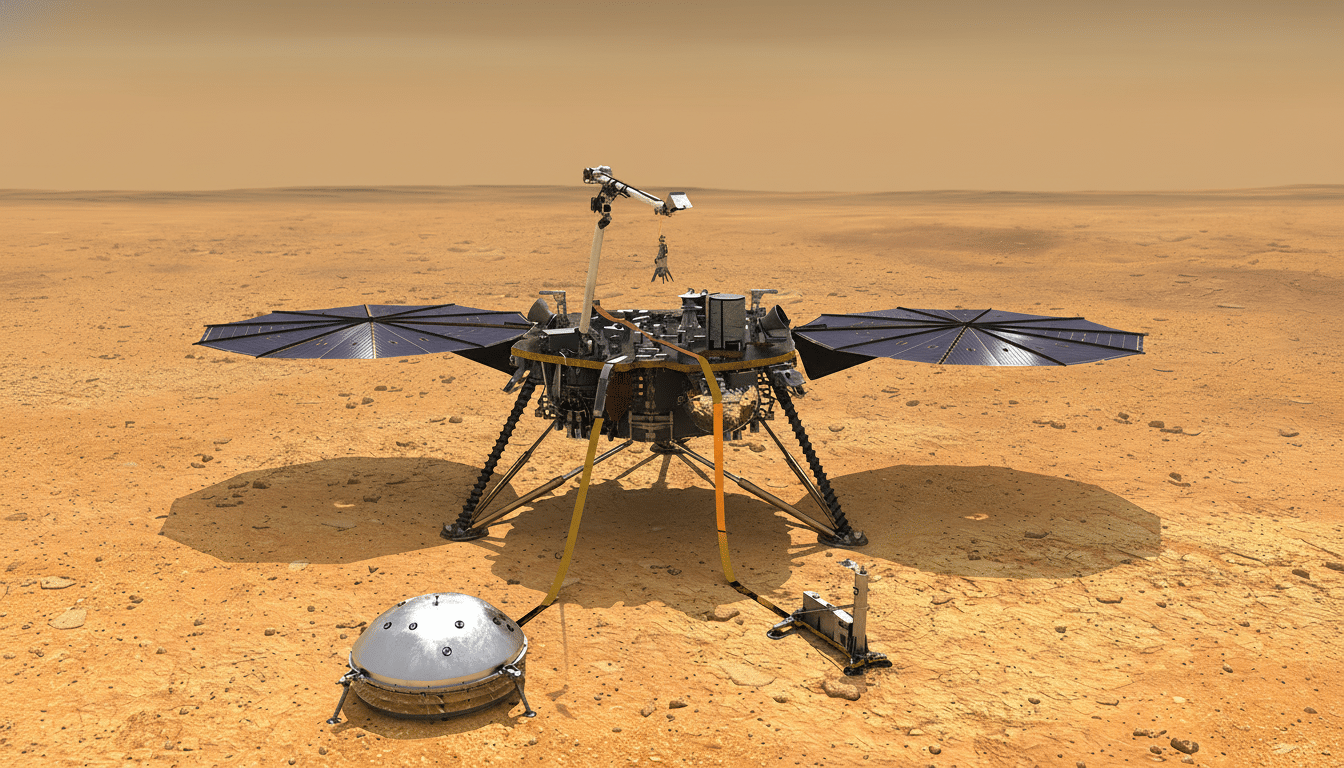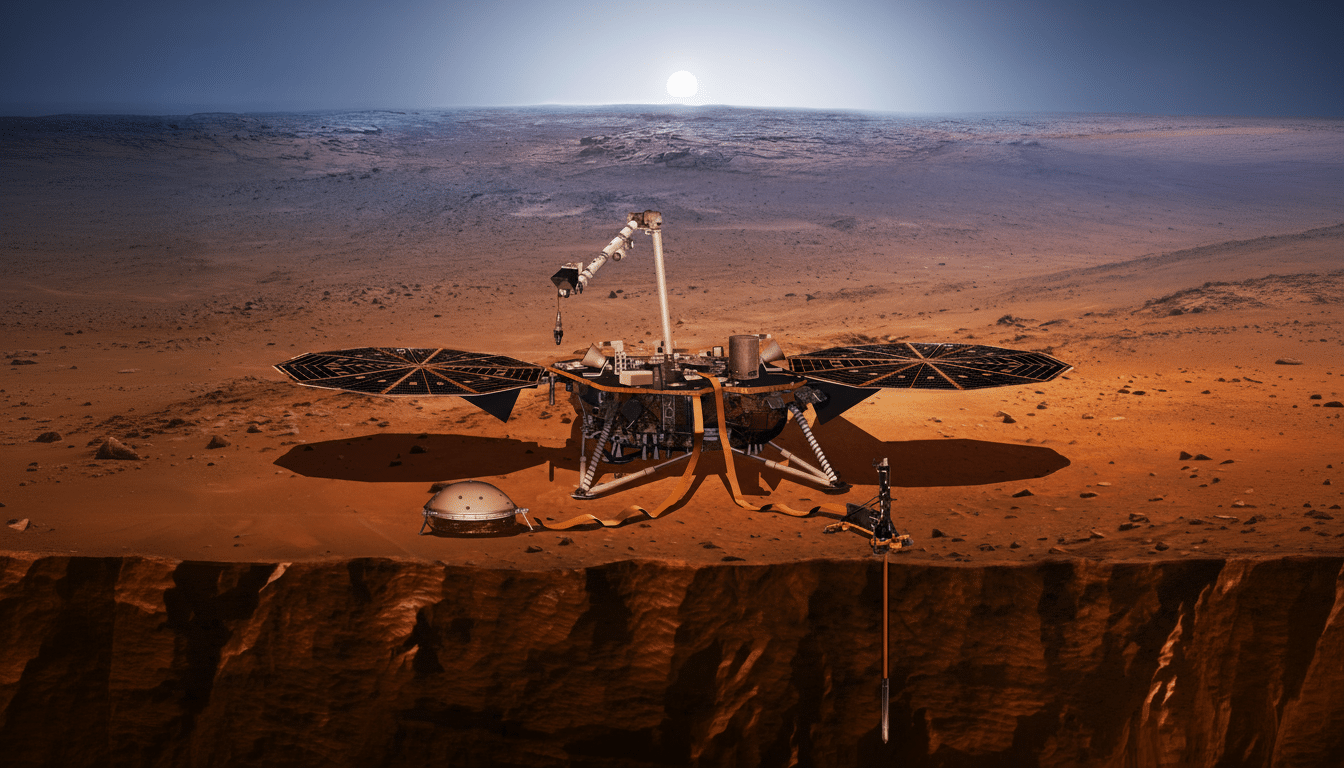Some new seismic sleuthing has helped solve the mystery of whether or not Mars is a layer cake. Beneath the rusted crust, the planet’s mantle seems to be pockmarked by kilometer-scale chunks, perhaps the remnants of giant objects that crashed into the young planet, leaving debris frozen in place.
The results, based on a reanalysis of data collected by NASA’s InSight lander, show seismic waves breaking up on large, compositionally dissimilar clumps embedded in the Martian mantle, according to a team of researchers at Imperial College London. And some of those chunks may be as wide as four kilometers, which is large enough to somehow disturb quake waves in observable ways.

InSight’s quakes reveal a messy mantle
InSight’s hyper-sensitive seismometer picked up more than a thousand marsquakes, but a handful of especially clear events proved most telling. As researchers traced how compressional and shear waves ricocheted around the inside, they saw the telltale interference and multipathing — signatures that rather than racing through uniform rock, the waves had been bouncing off of dense pockets and patches.
In seismology, that type of scattering indicates “strong contrasts” between rock properties like composition, temperature or porosity. On Mars, the best guess is ancient, unaltered bits: stuff with different mineral recipes and densities that somehow survived the planet’s violent genesis. According to the team’s models, clusters a few kilometers across can replicate the observed wave-like pattern.
The InSight mission was led by NASA’s Jet Propulsion Laboratory, with the French space agency, CNES, and the Institut de Physique du Globe de Paris (IPGP) as the principal partners in the experiment that included the Swiss Federal Institute of Technology (ETH Zürich). That international hardware, now resting quietly on Elysium Planitia, has redrawn textbooks of Martian interiors.
Leftover from giant impacts and magma oceans
Early Mars was pummeled by major impacts from large planetary embryos—bodies capable of gouging out basins like Hellas, Isidis, and Utopia. Every impact would have injected into the crust and the mantle enough energy to create local or global magma oceans. When they cooled down, those oceans froze in uneven layers, creating chemically stratified layers and dense cumulates.
If chunks of those cumulates and bits of the impactors themselves fell or were injected into the mantle, they might create the mishmash of rock now detected in the seismic data. The analysis, by Imperial College London and published in Science, contends that Mars never thoroughly mixed those leftovers, resulting in a patchy mantle freckled with ancient material from those early collisions.

That picture fits clues from Martian meteorites, which bear remarkable isotopic variety despite hailing from one planet. It also serves to explain why Martian volcanism — read the Tharsis bulge and Olympus Mons — seems so long-lived and geographically anomalous, a mantle that owes its buoyancy and melt channels to pockets of contrastingly composed goo.
Why Mars has held onto its crumbs, while Earth has not
Earth’s plate tectonics keep shaking up and regurgitating the crust into the mantle, mixing the planet’s interior like batter. Mars has “stagnant-lid” tectonics: Its single, thick crust rests above a mantle that isn’t mixed up through the downward churning of subduction. That lid served a purpose, effectively capping the chaos in the early solar system and keeping the deep interior of the planet a time capsule of its violent youth.
What this means in practice, is that Mars could retain seismic anomalies for billions of years. Regions of dense, iron-rich cumulates may be adjacent to lighter, more fusible ones: a mosaic of melt sources and heat-flow paths. Those contrasts change seismic speeds, enough to scatter quake waves and allow scientists to map hidden relics of formation using just a single seismometer station.
What the hidden debris means for future missions
A mantle full of chunks shifts the stakes for both sample return and future drilling. Igneous rocks brought back by Mars Sample Return could sample melts from compositionally distinct reservoirs, exposing multiple “mantles” within a single planet through isotopic systems like tungsten, neodymium, or oxygen. It’s that kind of diversity that would make the case for giant impacts seeding long-lived chemical heterogeneity.
It also reshapes thermal models. Dense tombstones can pin down mantle flow, direct the rise of magma, and determine where on a planet’s surface there are volcanoes. They could help explain why Mars lost its global magnetic field relatively early: If heat transport is patchy and inefficient, the core’s dynamo may stall early than simple, well-mixed models predict.
Seismology remains the key. A next-generation network of landers — or even a single station that operates longer and scans a wider range of frequencies — might be able to determine the size, depth and distribution of these buried fragments. After one marsquake per day in the months of continuous monitoring beginning last year, the scientists — at JPL; Imperial College London; and their partner institutions — are learning to read the Red Planet’s fossilized bruises, and they tell a story of ancient cosmic debris that still remains here and there.

